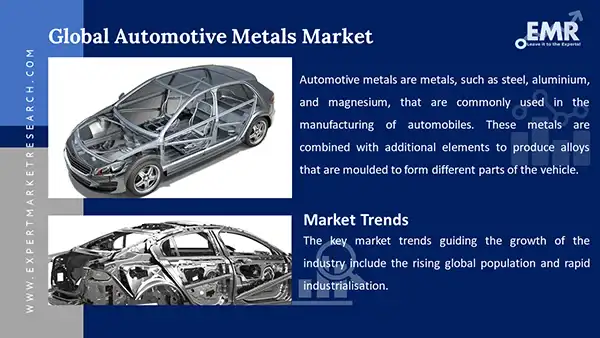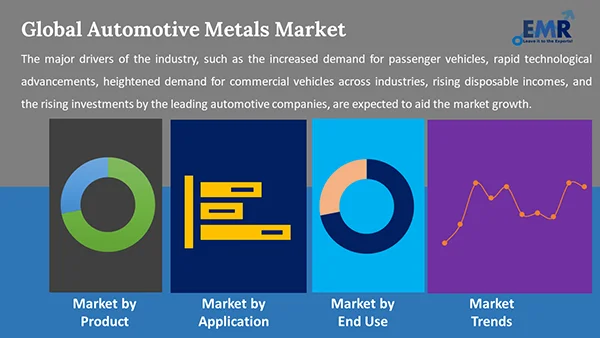
Consumer Insights
Uncover trends and behaviors shaping consumer choices today
Procurement Insights
Optimize your sourcing strategy with key market data
Industry Stats
Stay ahead with the latest trends and market analysis.
The global automotive metals market stood at a value of around USD 126.69 Billion in 2025. The market is further expected to grow at a CAGR of 6.20% in the forecast period of 2026-2035 to attain a value of USD 231.20 Billion by 2035.
Base Year
Historical Period
Forecast Period
Compound Annual Growth Rate
6.2%
Value in USD Billion
2026-2035
*this image is indicative*
Based on end use, the heavy commercial vehicles segment is predicted to hold a significant market share in the automotive metals industry. This growth can be attributed to the increased investments in the infrastructure development across the world. This is leading to the heightened demand for heavy commercial vehicles worldwide, which is anticipated to propel the market growth. Furthermore, the increased industrialisation is also projected to aid the market growth in the coming years.

Read more about this report - REQUEST FREE SAMPLE COPY IN PDF
The Asia Pacific is estimated to hold a substantial share of the automotive metals industry in the forecast period. This growth can be attributed to the presence of the leading market players in the region. In addition, the rising government investments supporting infrastructure development activities in the region are also predicted to drive the demand for heavy duty vehicles for construction applications. The rising population is augmenting the demand for residential, commercial, and industrial infrastructure, thereby, bolstering the market growth in the forecast period.

Read more about this report - REQUEST FREE SAMPLE COPY IN PDF
Automotive metals are metals, such as steel, aluminium, and magnesium, that are commonly used in the manufacturing of automobiles. These metals are combined with additional elements to produce alloys that are moulded to form different parts of the vehicle. Different metals offer different advantages, for instance, steel aids in the process of absorbing impact energy in a crash situation. Aluminium and magnesium, on the other hand, helps to reduce the overall weight of the car’s body, thus, reducing the fuel requirement.
By product, the market is divided into:
On the basis of application, the market can be segmented into:
On the basis of end use, the market can be distributed into:
The regional markets for the product include:
The automotive metals industry is being driven by the growing automotive sector and the increasing demand for vehicles. The growing global population, rising disposable incomes, and the improving living standards are leading to a rise in demand for transportation and passenger cars, thus, aiding the industry growth. In addition, the rising demand for heavy duty vehicles and machinery in the forecast period, which are essential in the construction industry, has been catalysing the market growth. Furthermore, the rapid technological advancements and the need to create lightweight vehicles to reduce energy consumption are also expected to aid the industry growth in the forecast period.
The report gives a detailed analysis of the following key players in the global automotive metals market, covering their competitive landscape, capacity, and latest developments like mergers, acquisitions, and investments, expansions of capacity, and plant turnarounds:
The comprehensive EMR report provides an in-depth assessment of the industry based on the Porter's five forces model and SWOT analysis.




*While we strive to always give you current and accurate information, the numbers depicted on the website are indicative and may differ from the actual numbers in the main report. At Expert Market Research, we aim to bring you the latest insights and trends in the market. Using our analyses and forecasts, stakeholders can understand the market dynamics, navigate challenges, and capitalize on opportunities to make data-driven strategic decisions.*
Get in touch with us for a customized solution tailored to your unique requirements and save upto 35%!
In 2025, the global automotive metals market attained a value of nearly USD 126.69 Billion.
The market is projected to grow at a CAGR of 6.20% between 2026 and 2035.
The major market drivers include the surging demand for passenger and commercial vehicles, rapid technological advancements, and increasing investments in R&D activities by leading automotive companies.
Rapid urbanisation and industrialisation and the surging population with high disposable incomes are the key trends fuelling the market demand for automotive metals.
The major regions in the market are North America, Latin America, the Middle East and Africa, Europe, and the Asia Pacific.
The significant products considered in the market report include aluminium, steel, and magnesium, among others.
The major applications of automotive metal include body structure, power train, and suspension, among others.
The significant end uses of the product include passenger cars, light commercial vehicles, and heavy commercial vehicles.
The major players in the market are ArcelorMittal, POSCO INTERNATIONAL Corporation, voestalpine Metal Forming GmbH, Tata Steel Limited, United States Steel Corporation, and thyssenkrupp AG, among others.
Explore our key highlights of the report and gain a concise overview of key findings, trends, and actionable insights that will empower your strategic decisions.
| REPORT FEATURES | DETAILS |
| Base Year | 2025 |
| Historical Period | 2019-2025 |
| Forecast Period | 2026-2035 |
| Scope of the Report |
Historical and Forecast Trends, Industry Drivers and Constraints, Historical and Forecast Market Analysis by Segment:
|
| Breakup by Product |
|
| Breakup by Application |
|
| Breakup by End Use |
|
| Breakup by Region |
|
| Market Dynamics |
|
| Competitive Landscape |
|
| Companies Covered |
|
| Report Price and Purchase Option | Explore our purchase options that are best suited to your resources and industry needs. |
| Delivery Format | Delivered as an attached PDF and Excel through email, with an option of receiving an editable PPT, according to the purchase option. |
Datasheet
One User
USD 2,499
USD 2,249
tax inclusive*
Single User License
One User
USD 3,999
USD 3,599
tax inclusive*
Five User License
Five User
USD 4,999
USD 4,249
tax inclusive*
Corporate License
Unlimited Users
USD 5,999
USD 5,099
tax inclusive*
*Please note that the prices mentioned below are starting prices for each bundle type. Kindly contact our team for further details.*
Flash Bundle
Small Business Bundle
Growth Bundle
Enterprise Bundle
*Please note that the prices mentioned below are starting prices for each bundle type. Kindly contact our team for further details.*
Flash Bundle
Number of Reports: 3
20%
tax inclusive*
Small Business Bundle
Number of Reports: 5
25%
tax inclusive*
Growth Bundle
Number of Reports: 8
30%
tax inclusive*
Enterprise Bundle
Number of Reports: 10
35%
tax inclusive*
How To Order

Select License Type
Choose the right license for your needs and access rights.

Click on ‘Buy Now’
Add the report to your cart with one click and proceed to register.

Select Mode of Payment
Choose a payment option for a secure checkout. You will be redirected accordingly.
Gain insights to stay ahead and seize opportunities.

Get insights & trends for a competitive edge.

Track prices with detailed trend reports.

Analyse trade data for supply chain insights.

Leverage cost reports for smart savings

Enhance supply chain with partnerships.

Connect For More Information
Our expert team of analysts will offer full support and resolve any queries regarding the report, before and after the purchase.
Our expert team of analysts will offer full support and resolve any queries regarding the report, before and after the purchase.
We employ meticulous research methods, blending advanced analytics and expert insights to deliver accurate, actionable industry intelligence, staying ahead of competitors.
Our skilled analysts offer unparalleled competitive advantage with detailed insights on current and emerging markets, ensuring your strategic edge.
We offer an in-depth yet simplified presentation of industry insights and analysis to meet your specific requirements effectively.
Share